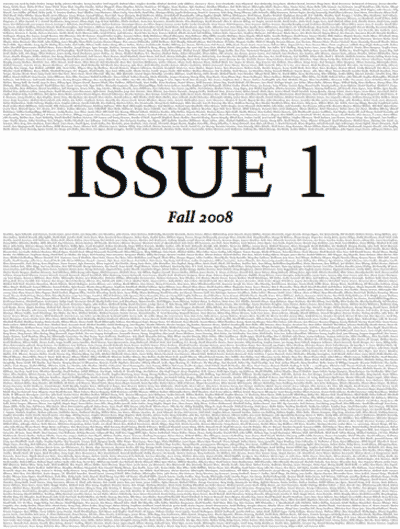Algorithmic Avant-Garde

There’s this new, controversial anthology of nearly 4,000 poems, entitled Issue 1. It is large enough to defy the limits of traditional bookbinding, with its 3,785 pages. It defies another assumption about books, too. This anthology was compiled by editors Stephen McLaughlin, Gregory Laynor & Vladimir and Aleksandrovich Zykov, but its contents weren’t exactly “written”. An article in Poetry Magazine’s blog describes exactly how the text was compiled. Suffice it to say that the book was generated, not written.
Issue 1 features the names of several thousand people, living and dead, poets and not. With each name is a poem, or at least what looks like a poem. These texts were not written by the people whose names accompany the texts. Instead, some of the texts appear to have been algorithmically generated by a computer program named Erica T. Carter.
It’s worth noting that the purpose of this computer program, aside from the linguistic parsing of patterns in English poetry, is to “disrupt the Academy’s mission of exclusion, its selfishness and greed, its supercilious arrogance. It does so by composing texts that democratize both the processes of reading and writing. It’s obvious that many of Erica’s poems are as good as most of what emerges as academic verse. But more important, absent an author, any reader’s reading is a valid reading.”
Many of the people whose names appear in the Issue 1 publication are angry, because their names appear in the anthology, without permission, and alongside texts that they did not write. A good overview of the controversy was titled “How to Make a Poet Cry on the Interweb Using Search Technologies”
The people at forgodot.com announced early last week that they would release an anthology called "Issue 1″ with new poetry from [...] around 4000 names, most of which belong to contemporary poets who might be considered "avant-garde" and dead ones. [...] if you were [...] one of the other living poets they claimed they would publish, you would [...] go to their site and realize that you had neither submitted any poetry to them nor had given permission to use anything previously published. This would leave you with three options. You could get irate or elated that someone actually bothered to list your name with contemporaries and icons, or you could keep a wary eye on their site to see what would happen next. One way of doing that would be doing what I did: leave a comment and ask to be notified when others did the same. Your inbox would then flood with hundreds of comments.I blogged about it, other poets blogged about it, it became an instant internet meme. Everyone in the poetry world knew about it.
One of the most popular blogs about poetry is maintained by Ron Silliman, whose name was also used in Issue 1. He is one that might fall into the “irate” category, and he does have a point. After briefly reviewing what’s interesting about Issue 1, he concluded, Issue 1 is what I would call an act of anarcho-flarf vandalism
. (You may be wondering: what is Flarf, anyway?) Silliman and others have mentioned the possibility of legal action.
The PDF file that contains Issue 1 disappeared from the internet shortly after its publication - perhaps in response to the controversy - but it resurfaced. Along with it came a “polite clarification” from the editors. This kind of clarification is important to consider, before deciding whether to condemn or censor a work of art.
Indulge me in an obscure analogy. Let's say I sit down and write the most vile, nasty, over-the-line-type-of-toxic-racist missive I can think of. Better yet, rearrange some Google vomit into an original composition and save myself a few minutes. If I were to distribute this speech, it would be considered a hate crime. I could, however, shape this text into letterforms -- say, large 120pt letters composed of 10pt type. If I were to spell something like "racism is bollocks" out of such illegal text, the mode of reading would be altered. The formerly despicable statement would be neutralized.This is an approximation of my original expectations regarding the reception of this magazine. I expected its size, format, and (to my eye) clearly algorithmically generated content to make our intentions clear. I wholeheartedly support the world of small press publishing and small press writing. Following the distribution of Issue 1, I would consider myself to be a member of that community on some small scale.
A lot has been written about Issue 1 and not all of it is negative. In addition to this clarification, and the post on Poetry’s blog,a recent radio interview from Ceptuetics gives an account of the motivations and methods behind the creation of Issue 1. It has been pointed out that the appropriation here is nothing new, in the art world. Marcel Duchamp comes to mind for creating things similar to Issue 1. The difference, I suppose, is that DaVinci was long dead, and couldn’t be bothered when Duchamp added facial hair to the Mona Lisa. Rauschenberg erased a work of art by de Kooning, and de Kooning approved, reluctantly. So you see, something like Issue 1 is not without precedent.
For my part, I’m intrigued to see that my name made it on a list that is largely comprised of living, “post-avant” poets. Some of the other poets who were included have chosen to go ahead and “claim” the poetry that appears with their name. In closing, here’s “my” poem.
Improved existence and second habiliments
A habiliment of fore-ends
A habiliment of invasions
A habiliment of surgeons
A habiliment of banquets
A leverrier
A leverrier
A leverrier
A leverrier
Wrapping oxygen
Dissolving past
Dissolving existence
Dissolving plucking
Implored
Implored
— Dylan Kinnett